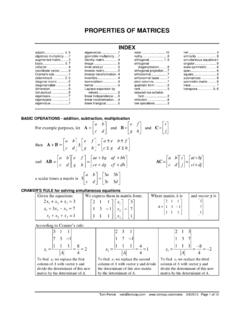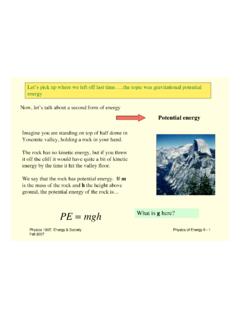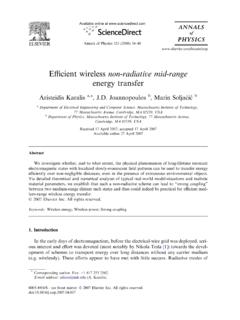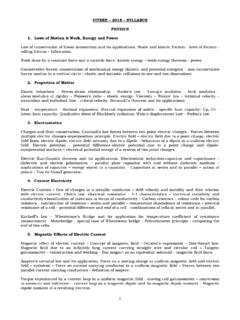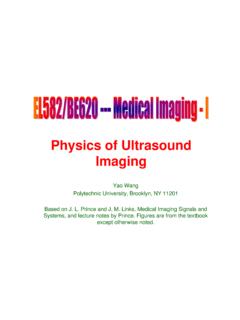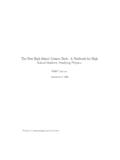Transcription of PHYSICS FORMULAS - Pacific Coast of Mexico
1 PHYSICS FORMULAS2426 Electron= 19 10-19 C= 10-31 kgProton= 19 10-19 C= 10-27 kgNeutron=0 C= 10-27 1023 atoms in one atomic mass unite is the elementary charge: 19 10-19 CPotential energy , velocity of electron: PE = eV = mv21V = 1J/C1N/C = 1V/m1J = 1 N m = 1 C V1 amp = 1018 electrons/second = 1 Coulomb/second1 hp = kW1 N = 1 T A m1 Pa = 1 N/m2 Power = Joules/second = I2R = IV [watts W]QuadraticEquation:xbbaca= 242 Kinetic energy [J]KEmv=122[Natural Log: when eb = x, ln x = b ]m: 10-3 : 10-6n: 10-9p: 10-12f: 10-15a: 10-18 Addition of Multiple Vectors:rrrrRABC=++Resultant = Sum of the vectorsrrrrRABC xxxx=++x-componentAAx=cos rrrrRABC yyyy=++y-componentAAy=sin RRRxy=+22 Magnitude (length) of R RyxRR= tan1 or tan RyxRR=Angle of the resultantMultiplication of Vectors:Cross Product or Vector Product: ijk =jik = ii =0 Positive direction:ijkDot Product or Scalar Product:ij =0ii =1ab =abcos kijDerivative of Vectors:Velocity is the derivative of position with respect to time.
2 Vkijk=++=++ddtxyzdxdtdydtdzdt()ijAcceler ation is the derivative of velocity with respect totime:akijk=++=++ddtvvvdvdtdvdtdvdtxyzx yz()ijRectangular Notation: ZRjX= where +j representsinductive reactance and -j represents capacitive example, Zj=+86 means that a resistor of 8 isin series with an inductive reactance of 6 .Polar Notation: Z = M , where M is the magnitude of thereactance and is the direction with respect to thehorizontal (pure resistance) axis. For example, a resistor of4 in series with a capacitor with a reactance of 3 wouldbe expressed as 5.
3 In the descriptions above, impedance is used as an and Polar Notation can also be used toexpress amperage, voltage, and convert from rectangular to polar notation:Given:X - jY(careful with the sign before the j )Magnitude:XYM22+=Angle:tan = YX(negative sign carried overfrom rectangular notationin this example)Note: Due to the way the calculator works, if X is negative,you must add 180 after taking the inverse tangent. If theresult is greater than 180 , you may optionally subtract360 to obtain the value closest to the reference convert from polar to rectangular (j) notation:Given:M X Value:Mcos Y (j) Value:Msin In conversions, the j value will have thesame sign as the value for angleshaving a magnitude < 180.
4 Use rectangular notation when addingand polar notation for multiplication and division. Multiply inpolar notation by multiplying the magnitudes and addingthe angles. Divide in polar notation by dividing themagnitudes and subtracting the denominator angle fromthe numerator YELECTRIC CHARGES AND FIELDSC oulomb's Law: [Newtons N]Fkqqr=122where:F = force on one charge bythe other[N]k = 109 [N m2/C2]q1 = charge [C]q2 = charge [C]r = distance [m]Electric Field: [Newtons/Coulomb or Volts/Meter]EkqrFq==2where.
5 E = electric field [N/C or V/m]k = 109 [N m2/C2]q = charge [C]r = distance [m]F = forceElectric field lines radiate outward frompositive charges. The electric fieldis zero inside a conductor.+-Relationship of k to 0:k= 140 where:k = 109 [N m2/C2] 0 = permittivity of free 10-12 [C2/N m2]Electric Field due to an Infinite Line of Charge: [N/C]Erkr= = 220E = electric field [N/C] = charge per unit length [C/m} 0 = permittivity of free 10-12 [C2/N m2]r = distance [m]k = 109 [N m2/C2]Electric Field due to ring of Charge.]
6 [N/C]EkqzzR=+()/2232or if z >> R, Ekqz=2E = electric field [N/C]k = 109 [N m2/C2]q = charge [C]z = distance to the charge [m]R = radius of the ring [m]Electric Field due to a disk Charge: [N/C]EzzR= + 21022E = electric field [N/C] = charge per unit area[C/m2} 0 = 10-12 [C2/N m2]z = distance to charge [m]R = radius of the ring [m]Electric Field due to an infinite sheet: [N/C]E= 20E = electric field [N/C] = charge per unit area [C/m2} 0 = 10-12 [C2/N m2]Electric Field inside a spherical shell: [N/C]EkqrR=3E = electric field [N/C]q = charge [C]r = distance from center of sphere tothe charge [m]R = radius of the sphere [m]Electric Field outside a spherical shell: [N/C]Ekqr=2E = electric field [N/C]q = charge [C]r = distance from center of sphere tothe charge [m]Average Power per unit area of an electric ormagnetic field.]]
7 WmEcBcmm/2202022== W = wattsEm = max. electric field [N/C] 0 = 4 10-7c = 108 [m/s]Bm = max. magnetic field [T]A positive charge moving in the same direction as the electricfield direction loses potential energy since the potential ofthe electric field diminishes in this lines cross EF lines at right Dipole: Two charges of equal magnitude andopposite polarity separated by a distance +QEkz=23pEz= 1203 pwhen z dE = electric field [N/C]k = 109 [N m2/C2] 0 = permittivity of free space 10-12 C2/N m2p = qd [C m] "electric dipole moment"in the direction negative topositivez = distance [m] from the dipolecenter to the point along thedipole axis where the electric fieldis to be measuredDeflection of a Particle in an Electric Field.
8 222ymvqEL=y = deflection [m]m = mass of the particle [kg]d = plate separation [m]v = speed [m/s]q = charge [C]E = electric field [N/C or V/mL = length of plates [m]Potential Difference between two Points: [volts V] VVVPEqEdBA= == PE = work to move a chargefrom A to B [N m or J]q = charge [C]VB = potential at B [V]VA = potential at A [V]E = electric field [N/C or V/md = plate separation [m]Electric Potential due to a Point Charge: [volts V]Vkqr=V = potential [volts V]k = 109 [N m2/C2]q = charge [C]r = distance [m]Potential energy of a Pair of Charges: [J, N m orC V]PEqVkqqr==2112V1 is the electric potential due toq1 at a point Pq2V1 is the work required to bringq2 from infinity to point PWork and Potential.]]
9 UUUWfi= = UW= WFd= =Fdcos Wqdif= Es VVVWqfi= = Vdif= EsU = electric potential energy [J]W = work done on a particle bya field [J]W = work done on a particlebrought from infinity (zeropotential) to its presentlocation [J]F = is the force vector [N]d = is the distance vector overwhich the force isapplied[m]F = is the force scalar [N]d = is the distance scalar [m] = is the angle between theforce and distance vectorsds = differential displacement ofthe charge [m]V = volts [V]q = charge [C]Flux: the rate of flow (of an electric field) [N m2/C] = EAd= EdA(cos) is the rate of flow of an electricfield [N m2/C] integral over a closed surfaceE is the electric field vector [N/C]A is the area vector [m2] pointingoutward normal to the ' Law.
10 =0 qenc = 0 EAdqenc 0 = 10-12 [C2/N m2] is the rate of flow of an electricfield [N m2/C]qenc = charge within the gaussiansurface [C] integral over a closed surfaceE is the electric field vector [J]A is the area vector [m2] pointingoutward normal to the Capacitor:CAd= 0C = capacitance [farads F] = the dielectric constant (1) 0 = permittivity of free space 10-12 C2/N m2A = area of one plate [m2]d = separation between plates [m]Cylindrical Capacitor:CLba= 20 ln(/)C = capacitance [farads F] = dielectric constant (1) 0 = 10-12 C2/N m2L = length [m]b = radius of the outerconductor [m]a = radius of the innerconductor [m]Spherical Capacitor:Cabba= 40 C = capacitance [farads F] = dielectric constant (1) 0 = 10-12 C2/N m2b = radius, outer conductor[m]a = radius, inner conductor [m]Maximum Charge on a Capacitor.


